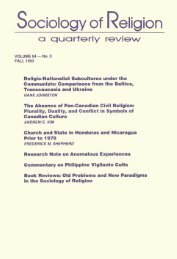The Sources of Gender Role Attitudes among Christian and Muslim ...
The Sources of Gender Role Attitudes among Christian and Muslim ...
The Sources of Gender Role Attitudes among Christian and Muslim ...
Create successful ePaper yourself
Turn your PDF publications into a flip-book with our unique Google optimized e-Paper software.
212 SOCIOLOGY OF RELIGION<br />
Arab surnames are common <strong>among</strong> other ethnic groups (e.g. Abraham <strong>and</strong><br />
Moses ate common <strong>among</strong> Jewish Americans) <strong>and</strong> <strong>among</strong> non-Arab <strong>Muslim</strong>s<br />
(e.g. Pakistanis), I used a filter question on Arab ancestry to exchde non-Amb<br />
respondents (phone conversation with Zogby, 1999). <strong>The</strong> question identifies the<br />
birthplace <strong>of</strong> the respondent, the respondent's mother <strong>and</strong> father, <strong>and</strong> the<br />
respondent's maternal <strong>and</strong> paternal gr<strong>and</strong>parents.<br />
<strong>The</strong> survey questionnaire was administered to a systematic, r<strong>and</strong>om sample<br />
<strong>of</strong> women drawn from these two frames. <strong>The</strong> final sample size was 501; a<br />
response rate <strong>of</strong> 47.2 percent. <strong>The</strong> median age <strong>of</strong> women sampled is 45 <strong>and</strong> their<br />
geographic distribution is similar to that found in the 1990 census -- 32.4<br />
percent ate clustered in the east/northeast (mainly in the New York <strong>and</strong><br />
Washington, DC areas), 35.3 percent ate located in the midwest (mainly in<br />
Detroit <strong>and</strong> Chicago), 25.6 percent live in the west (mainly in Los Angeles),<br />
<strong>and</strong>a minority (6.7 percent) live in the south.<br />
Though the sample is more geographically diverse than previous studies on<br />
Arab-American women, the ability to generalize findings remains limited, which<br />
is a common <strong>and</strong> <strong>of</strong>ten unavoidable problem in research on unidentified popula-<br />
tions, such as Arab Americans. Since the sampling frame is based on sumames,<br />
the most assimilated women ate likely underrepresented, those who have out-<br />
married or whose names have been Anglocized over time. <strong>The</strong> sample is likelu<br />
older <strong>and</strong> more highly educated than Arab Americans asa group, given the<br />
sampling frame characteristics (i.e., voluntary membership <strong>and</strong> registered<br />
voters). Since education is known to have a liberating impact on women's<br />
gender ideologies, the sample wŸ likely be skewed in that direction. However, it<br />
should be equally so for <strong>Muslim</strong>s <strong>and</strong> for <strong>Christian</strong>s. In sum, this research<br />
represents one <strong>of</strong> the first national studies <strong>of</strong> Arab-American women <strong>and</strong> has the<br />
unique ability to examine intra-ethnic, inter-religious differences in women's<br />
gender tole attitudes.<br />
Measures<br />
<strong>The</strong> dependent variable for this study is degree <strong>of</strong> gender traditionalism.<br />
<strong>Gender</strong> traditionalism is measured with a five-item index that gauges women's<br />
attitudes on marital roles, parenting, <strong>and</strong> non-traditional public roles. Each <strong>of</strong><br />
the five items has Likert~scale response categories ranging from (1) Strongly<br />
disagree to (5) Strongly agree. <strong>The</strong> resulting index ranges from 5 to 25, with<br />
higher scores representing greater support for traditional gender roles (alpha =<br />
.67). Appendix A provides additional information on variable measures.<br />
To identify cultural differences <strong>among</strong> Arab-American women, the indepen-<br />
dent variables include several dimensions <strong>of</strong> religion <strong>and</strong> ethnicity. Religious<br />
affiliation is operationalized with a dummy variable for <strong>Muslim</strong> affiliation, <strong>and</strong><br />
religiosity is operationalized with three variables measuring degree <strong>of</strong> religious<br />
involvement <strong>and</strong> strength <strong>of</strong> beliefs. <strong>The</strong> first item measures the respondent's<br />
Downloaded from<br />
http://socrel.oxfordjournals.org/<br />
by guest on January 18, 2013



